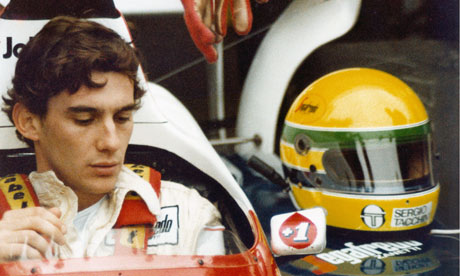Driven to an early grave

Ayrton Senna: devout Catholic, generous philanthropist and top Formula One driver.
Movies about motor sports have invariably arisen out of the personal enthusiasms of the actors or directors that made them. Steve McQueen, for instance, was the co-producer and star of Le Mans and did much of his own driving. Paul Newman did much of the same in Winning, his film about a racer's dream to win the Indianapolis 500. John Frankenheimer, who directed Grand Prix, the most expensive and ambitious of motor racing films, famously drove his guest Bobby Kennedy to the Ambassador Hotel the evening the senator was assassinated. He was driving so fast that Kennedy remarked: "Take it easy, John. Life is too short."
For Ayrton Senna, the Brazilian Formula One champion, life was indeed too short. He died, aged 34, after a crash in the 1994 San Marino Grand Prix, and both the producer, James Gay-Rees, and the film's writer, Manish Pandey, are great admirers of their subject and Formula One. They have created a viscerally exciting and intellectually stimulating documentary. The film's director, Asif Kapadia, had little previous knowledge of, or interest in, motor sports, but his two previous films, the features The Warriorand Far North, show his fascination with legend, tragedy and mystical experience which are essential elements of the Senna story.
The brilliantly edited film is based entirely on footage drawn from hundreds of hours of newsreel, material from Formula One's own archives, much of it previously unseen, and from the Senna family's home movies. There are no re-enactments or talking heads looking back over the career. But there are newly recorded voiced contributions by journalists and professional collaborators that are included over contemporary footage from the 70s, 80s and 90s. Only in a very general sense is the film a biography.
There is film of Senna's adolescent fascination with speed and his first trip to Europe to take part in go-kart racing, and we're told by theGuardian's Richard Williams that he was brought up in affluent circumstances by devoted parents. Their enthusiastic support of their son's passion is clear from shots of them at racing events. But we learn little about him that doesn't relate directly to racing. The various stages of his rise to Formula One are ignored, and in effect the film begins with the 1984 Monaco Grand Prix, the circuit most closely associated with his career and that made his reputation. He gave an astonishing performance driving a little-vaunted Toleman car in torrential rain and only lost on a technicality.
Over the next 10 years, the film traces the steady rise of this handsome, charismatic, articulate man as he moves cannily from team to team in this most dangerous and professionally competitive of sports. Along the way, he gives Formula One a jump start and becomes a national idol back in Brazil, a source of inspiration and a beacon of hope for a troubled nation. He has no illusions about Formula One – "it is political, it is money", but his sheer love of racing is evident when he claims that he was happiest in his go-karting days when there was no money or prizes.
What took him to the top, as managers and fellow drivers agree, was his gift for operating unflinchingly at speed and – the word of the McLaren boss Ron Dennis – "intellect". There is also the religious aspect. He was a devout Catholic, a remarkably generous philanthropist (the chief beneficiaries being disadvantaged Brazilian children), and on his grave is the epitaph: "Nothing can separate me from God." But his greatest rival, the Frenchman Alain Prost, went so far as to suggest that his religious faith was dangerous inasmuch as it made him believe he couldn't be killed. The combination of religion and ruthlessness comes over in a remarkable episode in the 1991 Brazilian Grand Prix when he drove the final laps in constant pain with his car stuck in sixth gear and his hands almost welded to the wheel by muscle spasms. "God gave me the race," he claims.
In an amusing exchange early on in the film, Prost asks: "Is it possible to be equal?" "No," says Senna. "Shit," Prost remarks. Prost, however, isn't always so likable, although he was to be one of Senna's pallbearers in São Paolo and collaborated on the making of this film. Their rivalry sems to have been extremely bitter. The chicanery involved on the two occasions they collided (at a chicane) in the 1989 Japanese Grand Prix brings to mind another race, the one in which those friends turned enemies, Messala and Ben-Hur, drove chariots. But nothing in the relationship with Prost compares with that between Senna and Jean-Marie Balestre, the French president of FIA (Fédération Internationale de l'Automobile, Formula One's governing body). Balestre comes over as a monstrously overbearing, manipulative, prejudiced figure, incapable of responding to criticism, and there's a chilling and very amusing exchange between the two at a drivers' meeting.
The film's tragic ending is deeply moving. There is the suggestion that, following the death a day earlier of the Austrian driver Roland Ratzenberger on the same San Marino circuit, Senna had had premonitions of his own death. An ironic contributing factor to the crash was mechanical instability resulting from the increased computerisation. Senna was in the process of initiating a scheme to make Formula One racing less dangerous. His friend, the British neurosurgeon, Professor Sid Watkins, took over, and since then there hasn't been a fatality in the sport.





0 comments:
Post a Comment